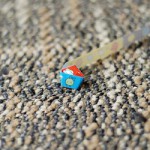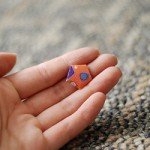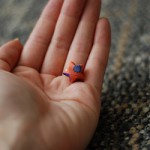- Jar of Paper Stars
- Various Kinds of Stars
- Paper for Stars
- Step One
- Step Two
- Step Three
- Step Four
- Done!
“All the girls would get this long strip of paper—expensive as hell—and you, like, fold it into little tiny stars—it has to be perfect, like, you can’t dent it anywhere—you make a thousand of them; and once you get to one thousand, you can make any wish, and it will come true.”
Q: “So do you only do this in a private setting, or do you do it with a bunch of other girls?”
A: “We did it in middle school—let’s see, we all had a bunch of paper and do it in front of each other, do it at home, or do it when we’re bored because we’re like, “I need to get that thousand!’”
Q: “Did you or anyone you know ever make it to a thousand stars?”
A: “I knew a couple people who did. They were like, “Yay! I got a thousand!” And, I don’t know what their wish was….”
Q: “Do you know if their wishes came true though?”
A: “No. But it made us really happy when, for presents, we’d give each other different designs of paper—there’s, like, the shiny foil; the little designs on them—we’d give them as gifts, and we’d be like, “Yes!” There were clear ones….”
Q: “Can you describe briefly how you made the stars?”
A: “Someone gave me a paper, and I was like, “I don’t know how to do this.” So, my older friends would teach me how to make it. And I was like, “Oh my God, I’m learning something important!” But, first you make a knot at one end, and then you keep folding over and over and over until you have a flat pentagon; and then you squeeze the corners. And you get a 3D star. And then you put it in those, like, collectible jars.”
My informant has demonstrated for me how to make these paper stars which are folk objects tied to the folk belief that if a person could make one thousand perfect paper stars, his or her wish would come true. Though she has never achieved this goal, she told me that she was never an adamant believer of it in the first place—she only made them because they were fun way to pass the time and hang out with friends.
The folk object and folk belief have been commercialized over the years to target Asians—a folk object that makes its greatest profit by selling back to its own culture. This item often targets tween to teenage girls who go on to eventually teach younger girls how to make these stars and tell them that they will be able to make a wish if they can make one thousand perfect stars. I think that the stars play on the romantic idea that stars are lucky and somehow possess powers to grant a person’s wishes. Perhaps the reason a wish can only be granted after a person has made one thousand perfect ones because it will demonstrate that the individual in question has demonstrated skills and patience worthy enough of one granted wish. Or perhaps the creation of a thousand stars as perfect as the ones found only in the heavens proves that a person is “god-like” enough to have a wish granted—somehow being able to create these perfect stars demonstrates mastery over the heavens.








